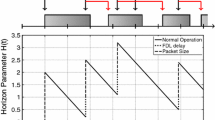Abstract
In order to achieve service differentiation, especially loss differentiation, in optical burst switching (OBS) networks, we propose a dynamic fiber delay line (FDL) partitioning algorithm, which divides FDLs into several groups over a feed-forward output buffering architecture. In the proposed scheme, a plurality of traffic classes and FDL groups can be considered, and each FDL group is assigned to traffic classes, so that the target loss probabilities of classes are guaranteed. Also, the optimal number of FDLs for each FDL group by the proposed algorithm is decided in Poisson traffic environments. The extensive simulation results validate the effectiveness of the proposed dynamic FDL partitioning algorithm for the loss differentiation in OBS networks.
Similar content being viewed by others
References
Qiao C. and Yoo M. (1999). Optical burst switching (OBS)—a new paradigm for an optical internet. J. High Speed Networks 8(1): 69–84
Long, K., Tucker, R.S., Wang, C.: A new framework and burst assembly for IP DiffServ over optical burst switching networks. In: Proceedings of the IEEE Globecom ’03, vol. 6, pp. 3159–3164, San Francisco, CA (2003)
Cao, X., Li, J., Chen, Y., Qiao, C.: Assembling TCP/IP packets in optical burst switched networks. In: Proceedings of the IEEE Globecom ’02, vol. 3, pp. 2808–2812, Taipei, Taiwan (2002)
Turner J.S. (1999). Terabit burst switching. J. High Speed Networks 8(1): 3–16
Xiong Y., Vandenhoute M. and Cankaya H.C. (2000). Control architecture in optical burst-Switched WDM networks. IEEE J. Select. Areas Commun. 18(10): 1838–1851
Oh S., Kim Y., Yoo M. and Hong H.H. (2002). Survivability in the optical internet using the optical burst switch. ETRI J. 24(2): 117–130
Kim, S., Kim, N., Kang, M.: Contention resolution for optical burst switching networks using alternative routing. In: Proceedings of the IEEE ICC ’02, vol. 5, pp. 2678–2681, New York, NY, USA (2002)
Lee, S.K., Sriram, K., Kim, H.S., Song, J.S.: Contention-based limited deflection routing in OBS networks. In: Proceedings of the IEEE Globecom ’03, vol. 5, pp. 2633–2637, San Francisco, CA (2003)
Chen, Y., Hamdi, M., Tsang, D.H.K.: Proportional QoS over OBS networks. In: Proceedings of the IEEE Globecom ’01, vol. 3, pp. 1510–1514, San Antonio, CA (2001)
Yoo M., Qiao C. and Dixit S. (2000). QoS performance of optical burst switching in IP-over-WDM networks. IEEE J. Select. Areas Commun. 18(10): 2062–2071
Vokkarane V.M. and Jue J.P. (2003). Prioritized burst segmentation and composite burst-assembly techniques for QoS support in optical burstswitched networks. IEEE J. Select. Areas Commun. 21(7): 1198–1209
Loi, C., Liao, W., Yang, D.N.: Service differentiation in optical burst switched networks. In: Proceedings of the IEEE Globecom ’02, vol. 3, pp. 2313–2317, Taipei, Taiwan (2002)
Liu, J., Ansari, N.: Forward resource reservation for QoS provisioning in OBS systems. In: Proceeding of the IEEE Globecom ’02, vol. 3, pp. 2777–2781, Taipei, Taiwan (2002)
Zhang, Q., Vokkarane, V.M., Chen, B., Jue, J.P.: Early drop and wavelength grouping schemes for providing absolute QoS differentiation in optical burst-switched networks. In: Proceedings of the of IEEE Globecom ’03, vol. 5, pp. 2694–2698, San Francisco, CA (2003)
Zhang T., Lu K. and Jue J.P. (2006). Shared fiber delay line buffers in asynchronous optical packet switches. IEEE J. Select. Areas Commun. 24(4): 118–127
Hunter D.K., Chia M.C. and Andonovic I. (1998). Buffering in optical packet switches. IEEE J. Lightwave Technol. 16(12): 2081–2094
Karol M.J. and Hluchyj M.G. (1987). Input versus output queueing on a space-division packet switch. IEEE Trans. Commun. 35(12): 1347–1356
Almeida, R.C., Jr., Pelegrini, J.U., Waldman, H.: Delay-line buffer modeling for asynchronous optical networks. In: Proceedings of the SPIE OptiComm ’03, vol. 5285, pp. 381–391, Dallas, TX (2003)
Chlamtac I., Fumagalli A. and Suh C.J. (2000). Multibuffer delay line architectures for efficient contention resolution in optical switching nodes. IEEE Transac. Commun. 48(12): 2089–2098
Yamaguchi T., ichi Baba K., Murata M. and ichi Kitayama K. (2003). Scheduling algorithm with consideration to void space reduction in photonic packet switch. IEICE Transac. Commun. E86-B(8): 2310–2318
Tancevski, L., Castanon, G., Callegati, F., Tamil, L.S.: Performance of an optical IP router using non-degenerate buffers. In: Proceedings of the IEEE Globecom ’99, vol. 2, pp. 1454–1459, Rio de Janeireo, Brazil (1999)
Tancevski L. (2000). Optical routing of asynchronous, variable length packets. IEEE J. Select. Areas Commun. 18(10): 2084–2093
OPNET, http://www.opnet.com/
Author information
Authors and Affiliations
Corresponding author
Rights and permissions
About this article
Cite this article
Lee, Y., Kim, N. & Kang, M. Service differentiation scheme in OBS networks. Photon Netw Commun 15, 67–75 (2008). https://doi.org/10.1007/s11107-007-0089-7
Received:
Accepted:
Published:
Issue Date:
DOI: https://doi.org/10.1007/s11107-007-0089-7




